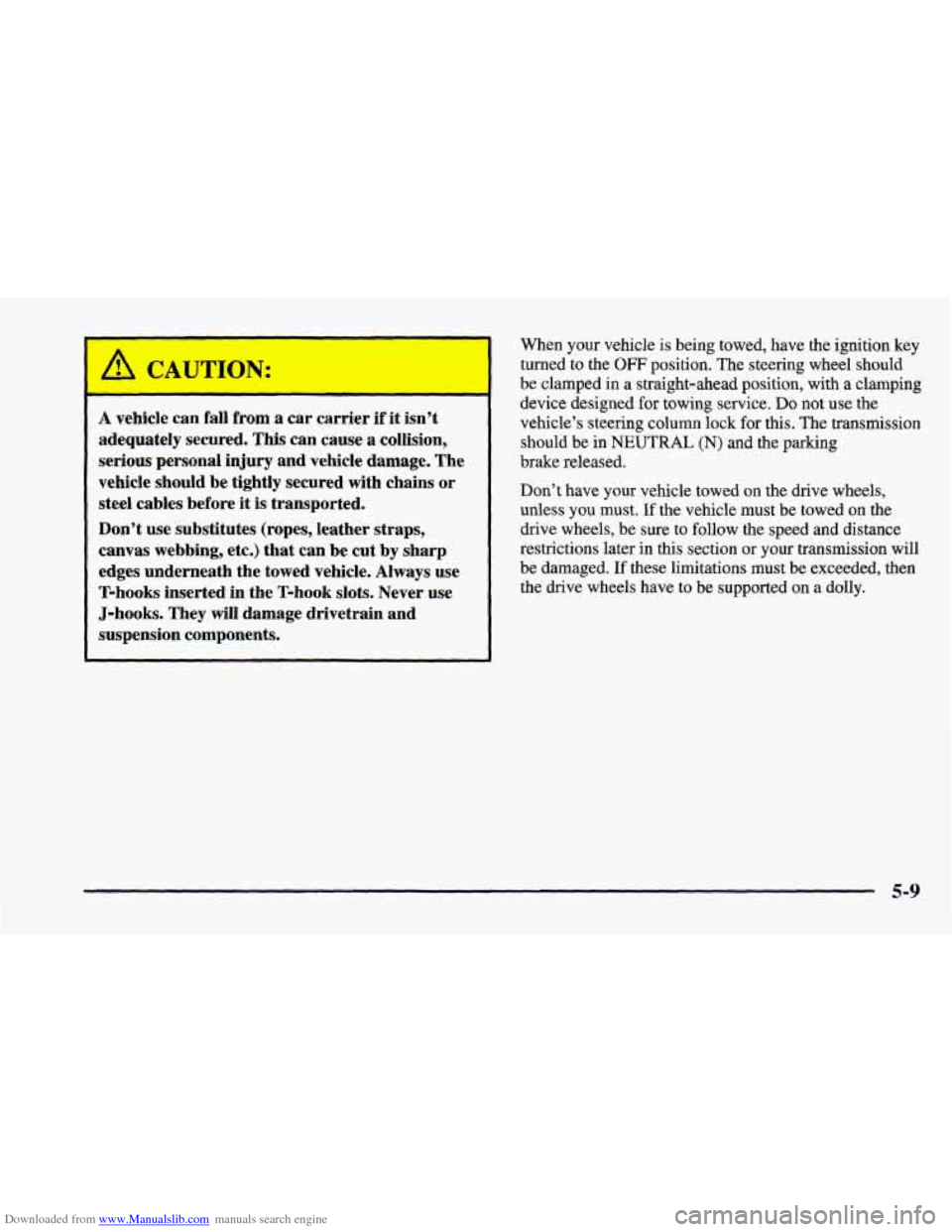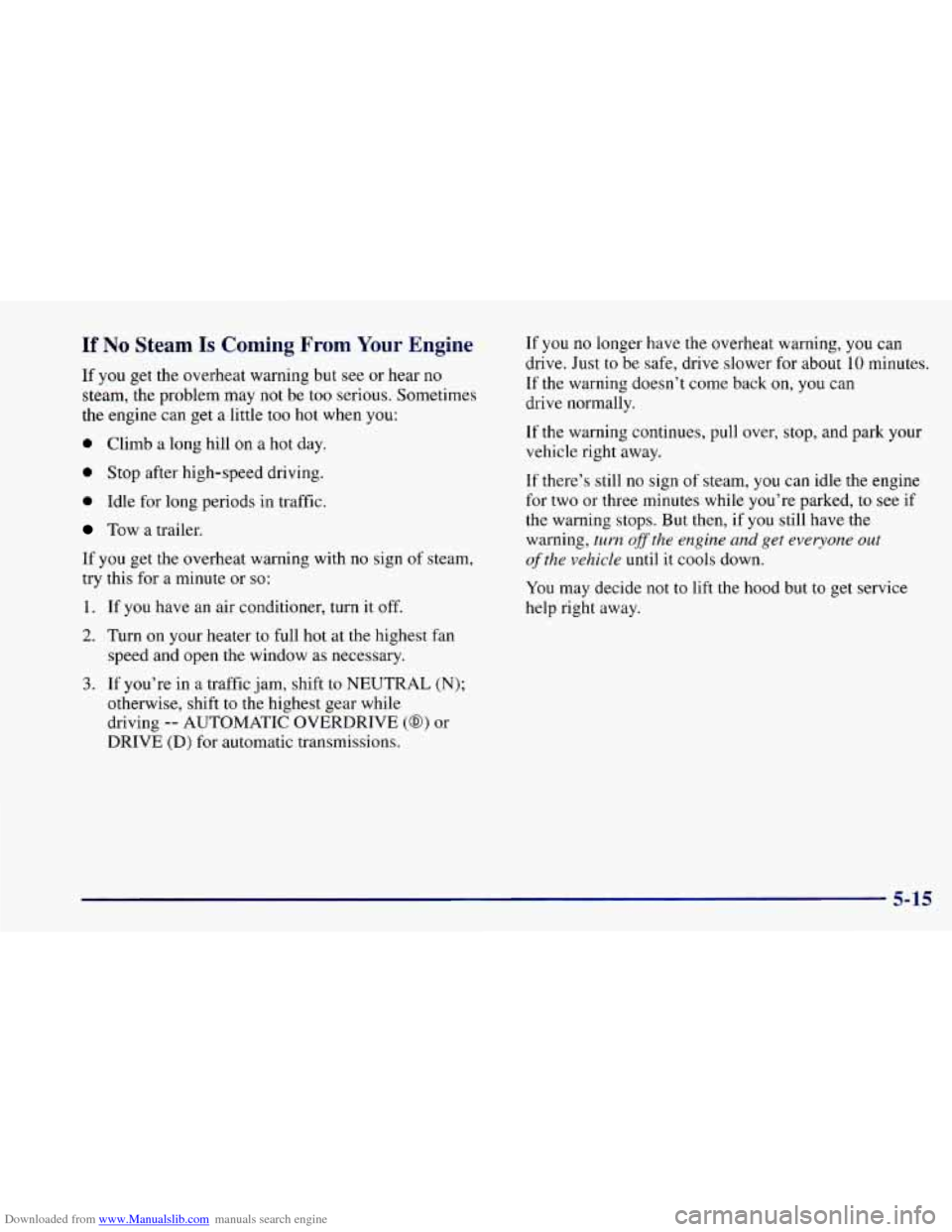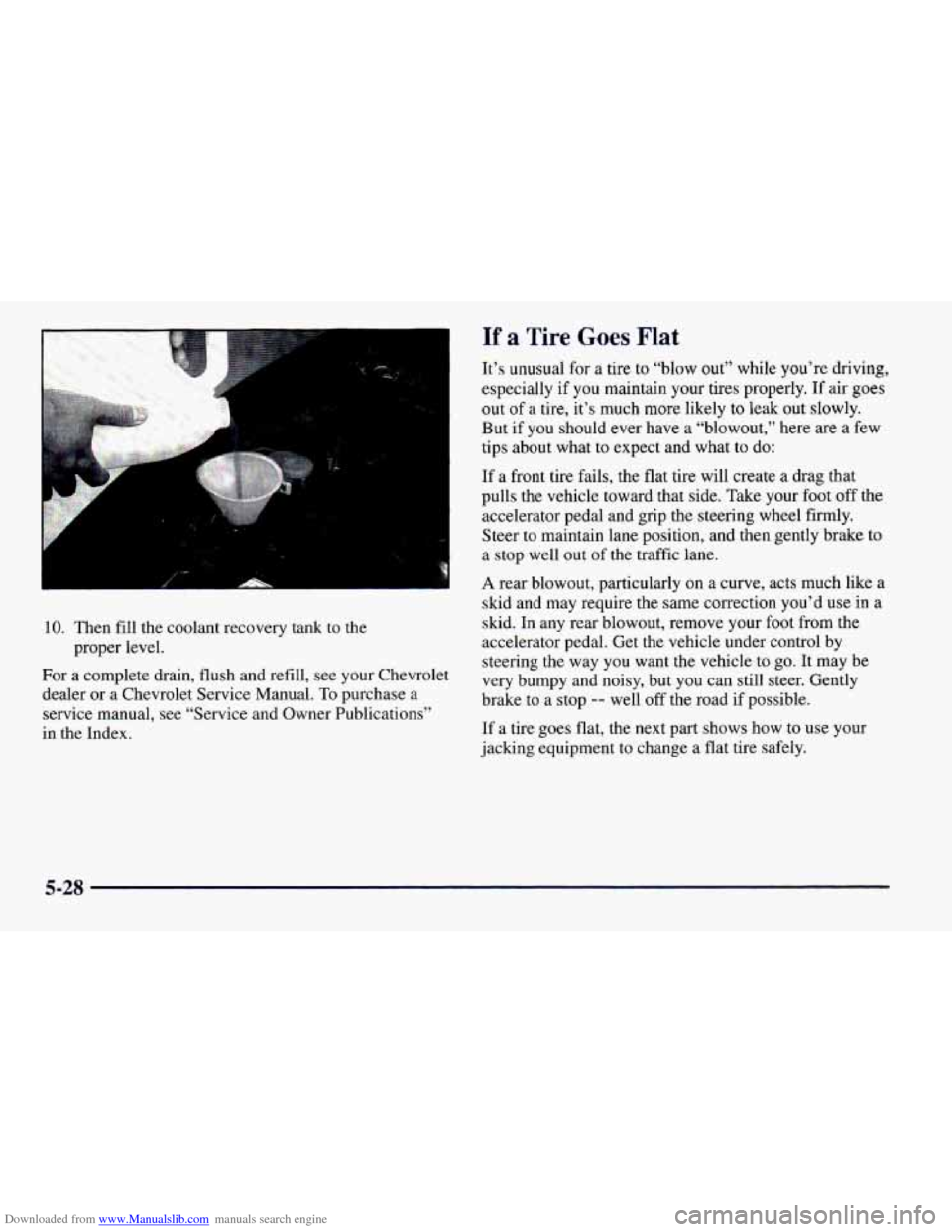Page 213 of 404

Downloaded from www.Manualslib.com manuals search engine A CAUTION:
A vehicle can fall from a car carrier if it isn’t
adequately secured. This can cause a collision,
serious personal injury and vehicle damage. The
vehicle should
be tightly secured with chains or
steel cables before it is transported.
Don’t use substitutes (ropes, leather straps,
canvas webbing, etc.) that can
be cut by sharp
edges underneath the towed vehicle. Always use
T-hooks inserted in the T-hook slots. Never use
J-hooks. They
will damage drivetrain and
suspension components.
When your vehicle is being towed, have the ignition key
turned to the OFF position.
The steering wheel should
be clamped in a straight-ahead position, with
a clamping
device designed for towing service.
Do not use the
vehicle’s steering column lock for this. The transmission
should be
in NEUTRAL (N) and the parking
brake released.
Don’t have your vehicle towed
on the drive wheels,
unless you must.
If the vehicle must be towed on the
drive wheels, be sure to follow the speed and distance
restrictions later in this section or your transmission will
be damaged.
If these limitations must be exceeded, then
the drive wheels have to be supported on
a dolly.
5-9
Page 214 of 404
Downloaded from www.Manualslib.com manuals search engine Front Towing
Tow Limits - 35 mph (56 kd), 50 miles (80 km)
Do not tow with sling-type equipment or fascidfog
lamp damage will occur.
Use wheel lift or car carrier equipment. Additional
ramping may be required for car-carrier equipment.
Use
safety chains and wheel straps.
I
Attach T-hook chains to the slots in the frame, rearward
of front wheels, on both sides.
NOTICE:
Do not attach winch cables or J-hooks to
suspension components when using car-carrier
equipment. Always use T-hooks inserted in the
T-hook slots.
5-10
Page 215 of 404
Downloaded from www.Manualslib.com manuals search engine Attach a separate safety chain around the outboard end
of each lower control arm.
NOTICE: I
Take care not to damage the brake pipes and
hoses
or the ABS sensor and wiring.
NOTICE:
Towing a vehicle over rough surfaces could
damage a vehicle, Damage can occur from
vehicle to ground or vehicle to wheel-lift
equipment contact,
To help avoid damage, install
a towing dolly and raise vehicle until adequate
clearance
is obtained between the ground and/or
wheel-lift equipment.
5-11
Page 216 of 404
Downloaded from www.Manualslib.com manuals search engine Rear Towing
I NOTICE: I
Do not attach winch cables or J-hooks to suspension
components when
using car-carrier equipment.
Always use
T-hooks inserted in the T-hook slots.
NOTICE:
Do not tow with sling-type equipment or rear
bumper valance will be damaged.
Use wheel-lift or car-carrier equipment.
Additional ramping may be required
for
car-carrier equipment.
Use safety chains and wheel straps.
Towing
a vehicle over rough surfaces could
damage
a vehicle. Damage can occur from
vehicle to ground or vehicle to wheel-lift
equipment contact.
To help avoid damage, install
a towing dolly and raise vehicle until adequate
clearance is obtained between the ground and/or
wheel-lift equipment.
5-12
Page 219 of 404

Downloaded from www.Manualslib.com manuals search engine If No Steam Is Coming From Your Engine
If you get the overheat warning but see or hear no
steam, the problem may not be too serious. Sometimes
the engine can get
a little too hot when you:
0 Climb a long hill on a hot day.
0 Stop after high-speed driving.
0 Idle for long periods in traffic.
Tow a trailer.
If
you get the overheat warning with no sign of steam,
try this for a minute or
so:
1. If you have an air conditioner, turn it off.
2. Turn on your heater to full hot at the highest fan
speed and open
the window as necessary.
3. If you’re in a traffic jam, shift to NEUTRAL (N);
otherwise, shift to the highest gear while
driving
-- AUTOMATIC OVERDRIVE (a) or
DRIVE (D) for automatic transmissions.
If you no longer have the overheat warning, you can
drive. Just to be safe, drive slower for about
10 minutes.
If the warning doesn’t come back on, you can
drive normally.
If the warning continues, pull over, stop, and park your
vehicle right away.
If there’s still no sign of steam, you can idle the engine
for two or three minutes while you’re parked,
to see if
the warning stops. But then, if you still have the
warning,
turn ofthe engine and get everyone out
of the vehicle until it cools down.
You may decide not
to lift the hood but to get service
help right away.
5-15
Page 232 of 404

Downloaded from www.Manualslib.com manuals search engine 10. Then fill the coolant recovery tank to the
For a complete drain, flush and refill,
see your Chevrolet
dealer or a Chevrolet Service Manual.
To purchase a
service manual, see “Service and Owner Publications”
in the Index. proper
level.
If a Tire Goes Flat
It’s unusual for a tire to “blow out” while you’re driving,
especially if you maintain
your tires properly. If air goes
out of a tire, it’s much more likely to leak out slowly.
But if you should ever have a “blowout,” here
are a few
tips about what to expect and what to do:
If a front tire fails, the flat tire will create
a drag that
pulls the vehicle toward that side. Take your foot off the
accelerator pedal and grip the steering wheel firmly.
Steer to maintain lane position, and then gently brake to
a stop well
out of the traffic lane.
A rear blowout, particularly on a curve, acts much like a
skid and may require the same correction you’d
use in a
skid. In any rear blowout, remove your foot from the
accelerator pedal. Get the vehicle under control by
steering the way you want the vehicle to
go. It may be
very bumpy and noisy, but you can still steer. Gently
brake to a stop
-- well off the road if possible.
If a tire goes flat, the next part shows how to use your
jacking equipment to change a flat tire safely.
5-28
Page 240 of 404
Downloaded from www.Manualslib.com manuals search engine A Ck 'JTION:
-
Rust or dirt on the wheel, or on the parts to
which
it is fastened, can make the wheel nuts
become loose after
a time. The wheel could come
off and cause an accident. When you change a
wheel, remove any rust or dirt from the places
where the wheel attaches to the vehicle. In an
emergency, you can use
a cloth or a paper towel
to do this; but be sure to use a scraper or wire
brush later, if you need to, to get all the rust
or
dirt off.
I
-
A CAUTION:
Never use oil or grease on studs or nuts. If you
do, the nuts might come loose. Your wheel could
fall
off, causing a serious accident.
Replace the wheel nuts with the rounded end of the
nuts toward the wheel. Tighten each
nut by hand
until the
wheel is held against the hub.
5-36
Page 246 of 404

Downloaded from www.Manualslib.com manuals search engine ~ NOTICE:
Spinning your wheels can destroy parts of your
vehicle as well as the tires.
If you spin the wheels
too fast while shifting your transmission back
and forth, you can destroy your transmission.
For information about using tire chains on your vehicle,
see “Tire Chains” in the Index.
Rocking Your Vehicle To Get It Out
First, turn your steering wheel left and right. That will
clear the area around your front wheels. If
your vehicle
has ASR, you should
turn the system off. (See “ASR
System” in the Index.) Then shift back and forth between
REVERSE (R) and a
forward gear (or with a manual
transmission, between FIRST
(1) or SECOND (2) and
REVERSE
(R)), spinning the wheels as little as possible.
Release the accelerator pedal while you shift, and press
lightly on
the accelerator pedal when the transmission is
in gear. If that doesn’t get you
out after a few tries, you
may need to be towed out. If you do need to be towed
out, see “Towing Your Vehicle” in the Index.
5-42